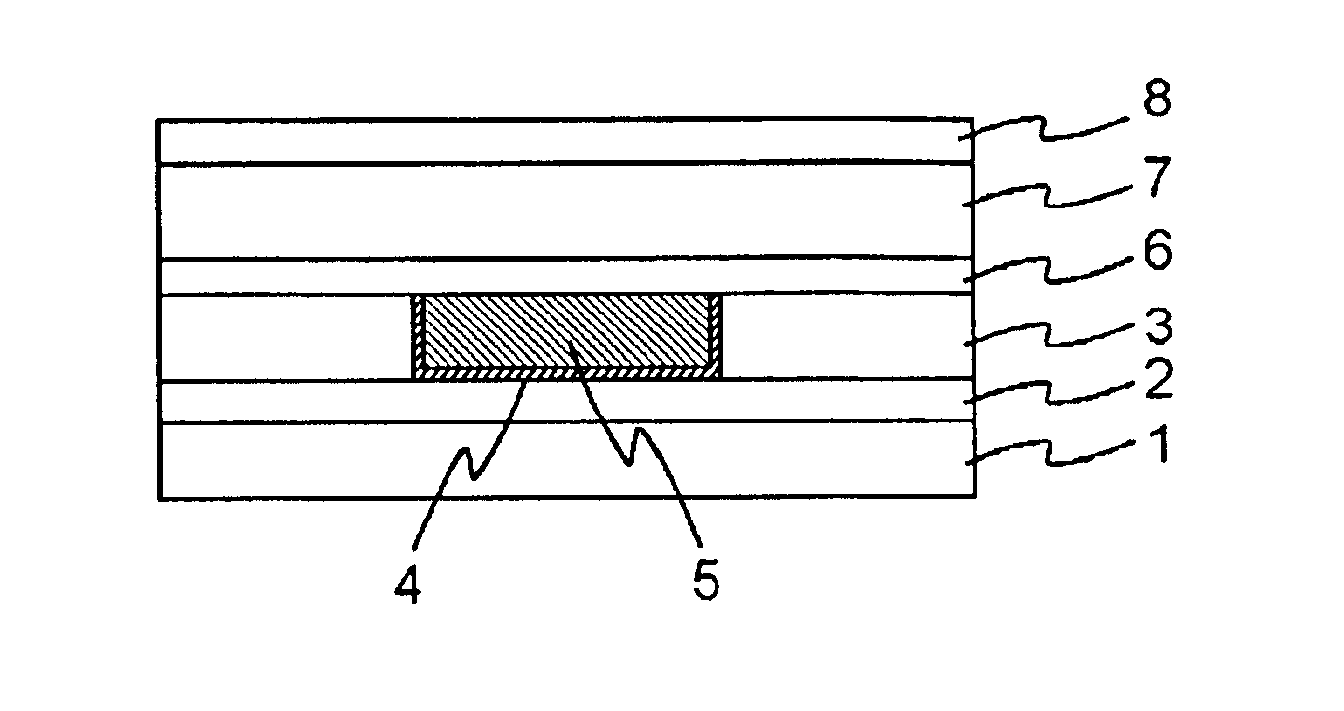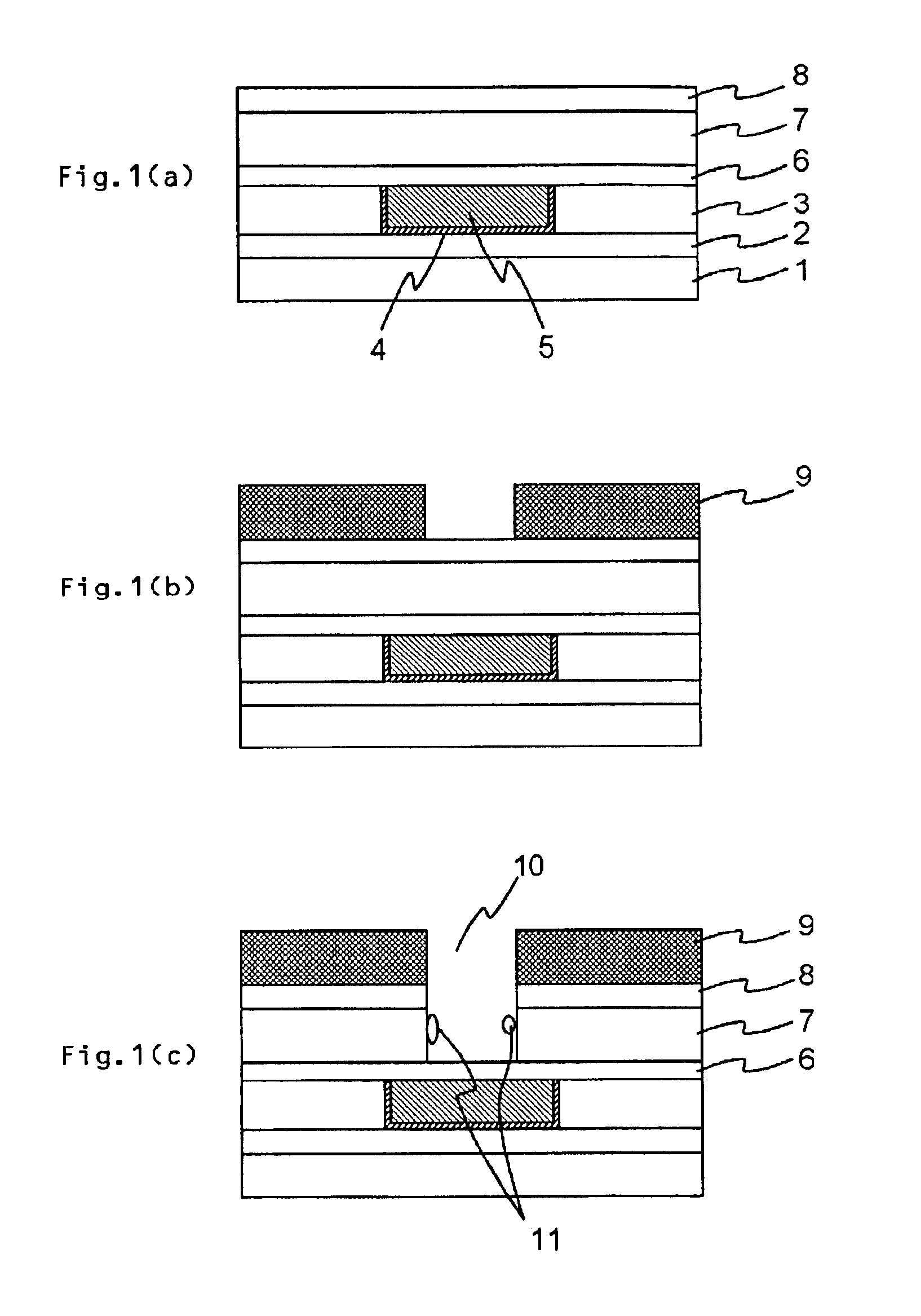Stripping composition
a composition and stripping technology, applied in the field of stripping compositions, can solve the problems of unfavorable anti-corrosion function and damage to certain types of low-dielectric films, and achieve the effects of excellent stripping composition, sufficient anti-corrosion ability, and excellent stripping composition
- Summary
- Abstract
- Description
- Claims
- Application Information
AI Technical Summary
Benefits of technology
Problems solved by technology
Method used
Image
Examples
example 1
The first stripping composition according to the present invention was applied to the process for forming a via hole on a copper wiring, and strippability and anticorrosive property were evaluated.
Samples for evaluation were made according to the process shown in FIG. 1(a) to FIG. 2(c). First, a copper wiring was formed on a silicon wafer, and then, a silicon nitride film of a thickness of 90 nm, a low-dielectric film of a thickness of 450 nm, and a silicon oxide film of a thickness of 450 nm were formed on the copper wiring. All of these films were formed using the plasma CVD method. Next, a positive-type resist was spin-coated to form a resist film. As the material of the resist film, a positive resist material for KrF, “PEX4” (Tokyo Ohka Kogyo Co., Ltd.) was used. This resist film was exposed through a mask pattern, and developed using an aqueous solution of tetramethyl ammonium hydroxide to obtain a resist pattern.
Using this resist film as a mask, the silicon oxide film and the ...
example 2
In the same manner as Example 1, a sample wherein an SiOC-based low-dielectric film having a copper wiring exposed on the bottom of the via hole was prepared. The sample was immersed in stripping compositions of Nos. 12 and 13 in Table 2 at room temperature (23° C.) for 10 minutes; thereafter the sample was directly rinsed with pure water, and evaluated in the same manner as in Example 1. Furthermore, unlike Example 1, continuous deposits of silicon oxide were observed on the surface of the sample before stripping treatment, and the removal of these deposits was also evaluated. For reference, the results obtained using the stripping composition of No. 2 used in Example 1 are also listed in Table 2.
TABLE 2Composition (wt %)StrippabilityCuStrippinga)b)d)e)c) LacticViaSurfacecorrosionFilm damage;agent No.THFAAdenineWater2MAEacidHFpHbottomoxideresistanceSiOC-based1291.00.0304.04.01.07.6CABB1387.00.0304.04.05.03.0CACC267.00.03019.06.08.00.08.6ADAA
As can be seen from Table 2, although the...
example 3
In order to confirm the effect of the anticorrosives, the anticorrosives in a typical composition (No. 2) of the stripping composition of Example 1 were changed, and strippability, such as the removal of deposits and anticorrosive ability to Cu, was evaluated. Sufficient strippability can be achieved when a generally used anticorrosive such as BTA is used; however, since purine and adenine, which is a derivative of purine, are biological materials, and excel in biodegradability, they can be used safely, and the waste can be treated easily. Therefore, they excel in environment consciousness.
TABLE 3StrippingStrippability ViaCu corrosionFilm damage;agent No.Anticorrosive (wt %)pHbottomresistanceSiOC-based2Adenine0.038.6AAA14Purine0.038.6AAA15BTA0.038.6AAAOther components: THFA 67.0, water 19, 2MAE 6, Lactic acid 8 (wt %)
PUM
| Property | Measurement | Unit |
|---|---|---|
| pH | aaaaa | aaaaa |
| chemical formula | aaaaa | aaaaa |
| weight | aaaaa | aaaaa |
Abstract
Description
Claims
Application Information
 Login to View More
Login to View More - R&D
- Intellectual Property
- Life Sciences
- Materials
- Tech Scout
- Unparalleled Data Quality
- Higher Quality Content
- 60% Fewer Hallucinations
Browse by: Latest US Patents, China's latest patents, Technical Efficacy Thesaurus, Application Domain, Technology Topic, Popular Technical Reports.
© 2025 PatSnap. All rights reserved.Legal|Privacy policy|Modern Slavery Act Transparency Statement|Sitemap|About US| Contact US: help@patsnap.com



